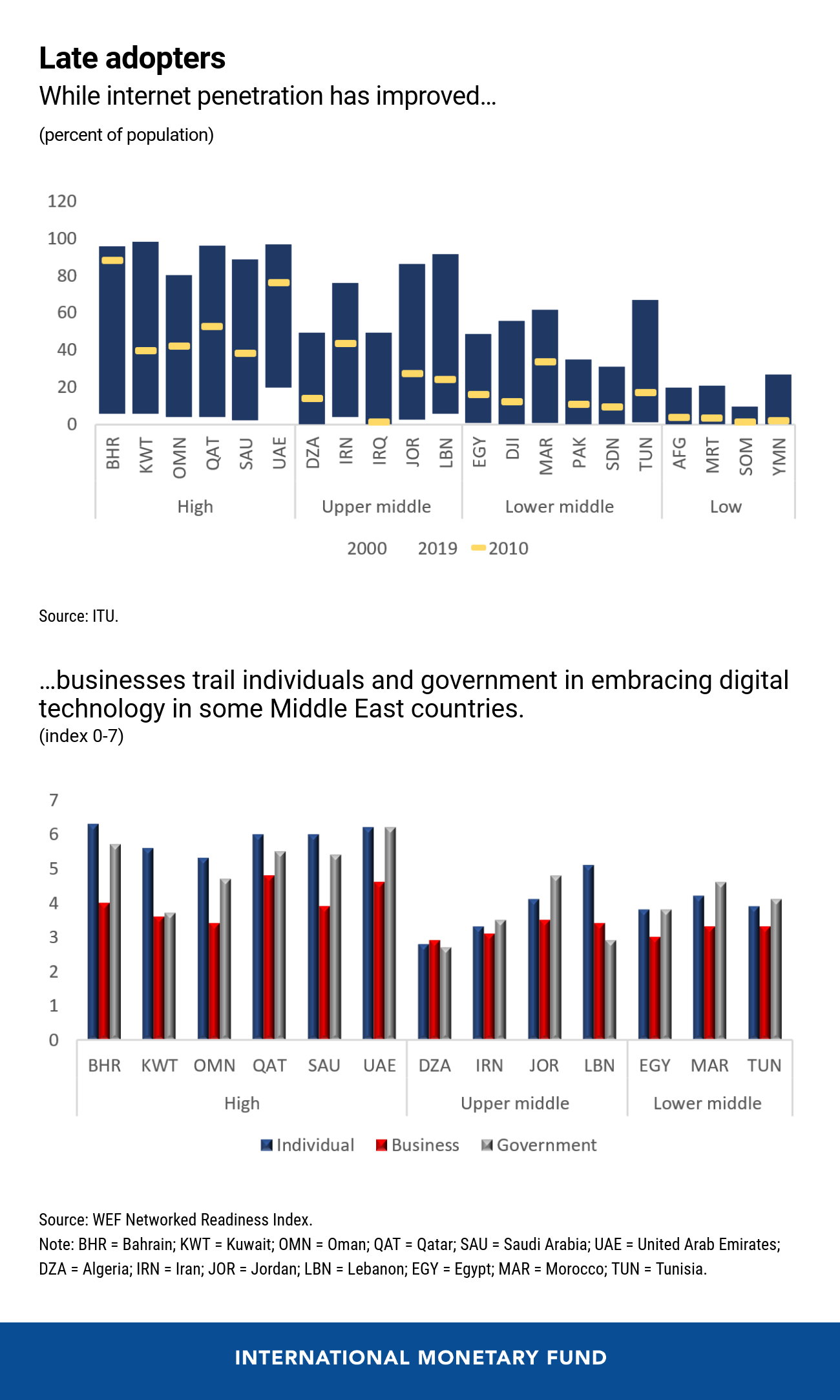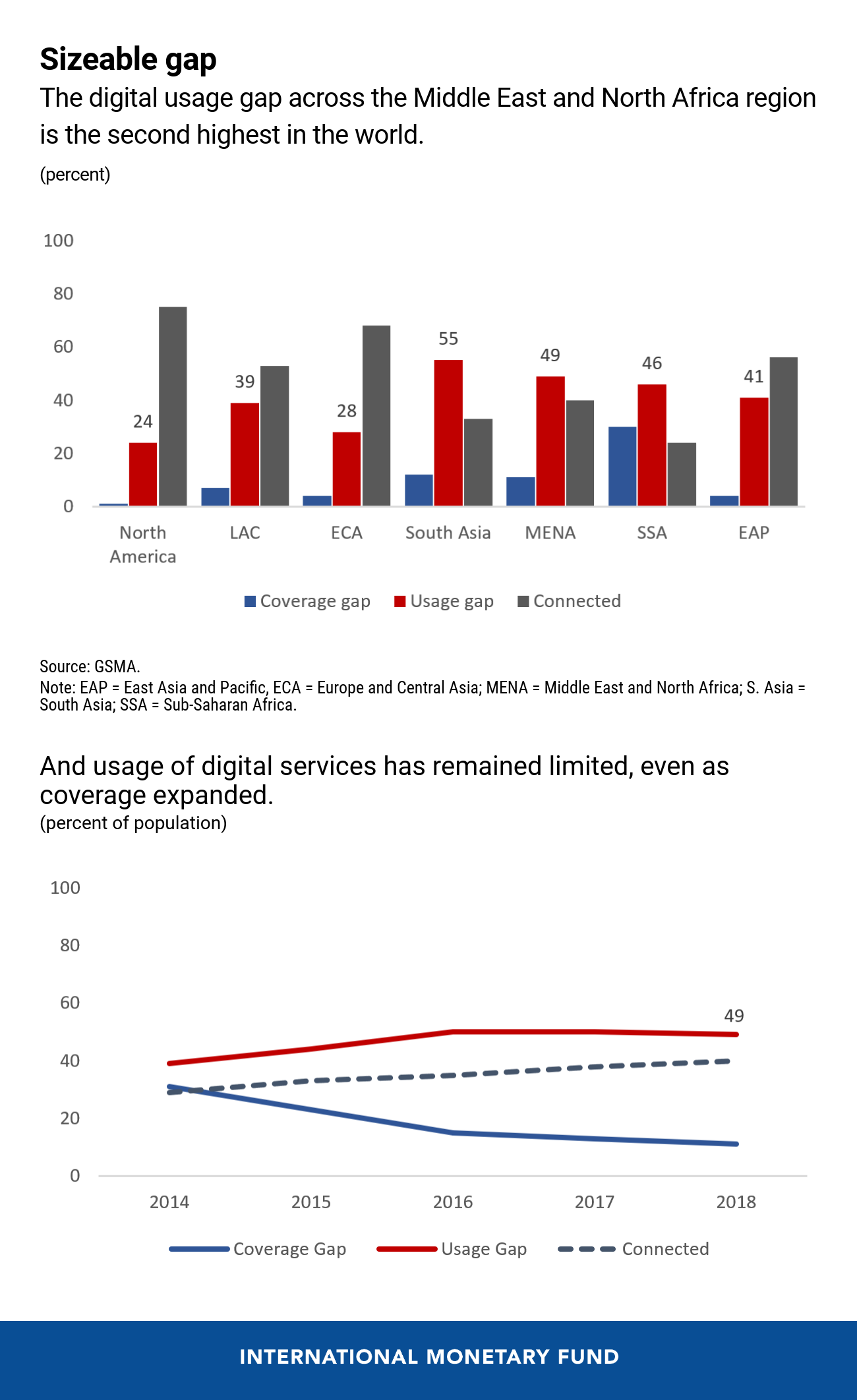Small and medium-sized enterprises dominate the business landscape in the Middle East and North Africa region. These enterprises account for more than 90 percent of the region’s businesses and, in some countries, contribute as much as 50 percent of employment and 70 percent of GDP.
Yet they face impediments to growth, and their contribution to employment is below potential. In much of the region, small and medium-sized enterprises are handicapped by limited access to credit, unfavorable business environments, and talent gaps.
Digital technologies present new opportunities for these businesses to achieve faster growth. Emerging technologies and broadband internet can facilitate operational efficiencies, innovation, access to markets and finance, and can enable firms to operate remotely during lockdowns. The flexibility of remote working can help integrate women and youth in the labor market.
But so far, small and medium-sized enterprises in the region have been slow to embrace digital technologies and e-commerce, and businesses trail governments and consumers in internet usage.

As consumers rapidly shift to online shopping and increasingly prefer rapid and convenient services, smaller businesses will need to adopt digital solutions to remain competitive and survive.
Because small and medium-sized enterprises hold the key to employment generation, governments can help expedite their digital transformation by developing and implementing national strategies that address both supply and demand constraints standing in the way of digitalization.
On the supply side, priority should be given to removing barriers to competition and increasing investment in information and communications technology to ensure universal access to affordable high-speed internet. Currently, while all countries have easy access to international fiber optic networks, many maintain barriers to entry such as government monopolies or restrictions on foreign participation and network peering. These, coupled with high capital investment requirements, have slowed deployment of advanced network technologies and internet exchange points. Apart from the Gulf Cooperation Council states of Bahrain, Kuwait, Oman, Qatar, Saudi Arabia, and the United Arab Emirates (GCC), many countries have limited access to high speed broadband internet, and internet services are often slow, unreliable, and unaffordable, constraining use of the internet for business creation.
Educational and labor market reforms are needed to reduce the digital skill gaps. Digital skills are in short supply across the Middle East and North Africa region and some countries with high levels of digital expertise, such as Lebanon and Egypt, sometimes suffer brain drain to higher income countries, including the GCC. Mandating science, technology, engineering and mathematics subjects and providing technical and vocational education and training through public-private partnerships can increase supply of tech skills in the medium term. At the same time, easing labor restrictions to facilitate expatriates in highly technical areas can reduce the skill gaps in the near term.
Reforms are also needed to improve E-commerce logistics and reliability of electricity, without which the Internet cannot function. Deficiencies in E-commerce logistics—unified address systems, area codes, postal service, land and customs clearance—currently delay delivery and increase costs for online trading.
Regulatory and other reforms are also essential to facilitate development of digital financial infrastructures. Digital financial services currently do not provide a strong foundation for digital transformation as the infrastructure and instruments for accepting electronic payments—such as point-of-sale terminals, credit and debit cards—have limited penetration, and payment systems are mostly not interoperable.
Digitalization of government services and procurement can incentivize small and medium-sized enterprises to follow suit given the significant size of the public sector in most countries and the pervasiveness of making payments to, or receiving payments from, governments.
On the demand side, the digital usage gap—the disparity between people who live in areas covered by broadband but who are not using internet—is several times the coverage gap. This suggests that demand is being constrained for reasons other than the non-availability of internet access.

To increase demand for digital services, governments should develop digital literacy and awareness programs as well as foster consumer trust by strengthening frameworks for cybersecurity, digital identification, data privacy, and consumer protection. Across the region, consumers reportedly do not trust websites to handle their information and are unaware of their consumer rights. In some countries, consumers are not well equipped to adopt digital solutions as large segments of the populations are not connected to the internet and are unbanked. In parts of the region, including North Africa and Iran, ownership of smartphones and other internet-enabled devices is below the global average.
Finally, for digital benefits to materialize, the digital strategy must be underpinned by financial sector and business environment reforms, particularly strengthening financial infrastructures—credit registries and bureaus, modernized bankruptcy laws, collateral registries—and business support, all of which will help SMEs access credit.






